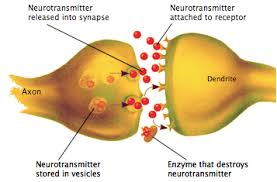Detailing Behavior

Neurotransmitters are chemical messenger molecules specialized for communication from neuron to neuron. Each neurotransmitter plays a different role in our bodies. For example, acetylcholine contributes to the regulation of memory, attention and arousal, while serotonin is involved in the regulation of sleep, wakefulness, eating and aggression. However, since neurotransmitters are just freely floating in the body, it’s easy for them to be modified by external forces. If, for example, your body wanted to dilute some pain, it could release chemicals that would stop neurotransmitters that would otherwise tell your brain that you’re in pain.
“Nature vs. Nurture” is a discussion among psychologist about whether a person’s physical and behavioral traits come from their innate qualities (nature) or their personal experiences (nurture).
An event that seems to support the nature theory is the story of David Reimer (Colapinto, 2004). David was born Bruce Reimer and he had a twin brother named Brian in 1965. The two boys were normal, but they had problems urinating; so, circumcisions were scheduled for both of them. However, the doctor used an electrocautery needle, instead of a scalpel to do the procedure, which resulted in Bruce’s entire penis being burned off.
Not knowing what to do about the unfortunate happening, Mr. and Mrs. Reimer were referred to Johns Hopkins Hospital in Baltimore, where the world’s leading expert in gender identity, Dr. John Money, recommend a surgical sex change for Bruce, from male to female, which would involve a synthetic vagina and estrogen supplements. Bruce’s parents eventually agreed to the radical procedure, believing it as their only hope to raising a child who could have heterosexual intercourse. This procedure was important to science because it could potentially prove the nurture, not nature, determines gender identity and sexual orientation. Brian, Bruce’s twin brother, could serve as the control, or norm. So, the procedure was successfully completed and Bruce was renamed Brenda.
However, things didn’t go as planned. Brenda rejected all things feminine. At age 2, she angrily tore off her dresses; she even refused to play with dolls and would beat up her brother and seize his toy cars and guns. Brenda was also noted as complaining to her parents and teachers that she felt like a boy. When she was 14, Brenda was told the truth about her medical history and was relieved, later saying, “Suddenly it all made sense why I felt the way I did. I wasn’t some sort of weirdo. I wasn’t crazy.” With this new knowledge, Brenda decided to undergo surgeries to become a male again and became David.
While this may seem to support the nature theory, there is one fact that should still be examined: Bruce didn’t become Brenda until he was almost two years of age. Couldn’t it be possible that he was already developing his sense of masculinity before the transformation and that the doctors and his parents were too late, in terms of him becoming a female? Would he, as Brenda have reacted the same way if the gender reassignment had taken place closer to birth?
Evidence of the nurture theory is the famous Bobo Doll experiment conducted in 1961 (Bandura, D. Ross, and S. Ross). In the experiment, 36 boys and 36 girls, ranging from 37 and 69 months of age, were divided into 8 experimental groups of 6 each, with one control group of 24. Half of the experimental group was exposed to an adult acting aggressively towards a blow-up doll, codenamed Bobo, while the other half was exposed to an adult who acted nonaggressive and subdued toward Bobo. Next, they were further separated into male and female groups, with half of them viewing an adult of their same sex and the other half viewing an adult of their opposite gender. The control group had no prior exposure to the adult models and was only tested in the generalization situation.
The test showed that boys reproduced more imitative physical aggression than girls, but they did not differ in their imitation of verbal aggression. It also raised the question of if it matters who the nurturer is. For example, male subjects who were exposed to an aggressive man exhibited more physical and verbal imitative aggression, more non-imitative aggression, and engaged in significantly more gun play than those exposed to an aggressive woman. In contrast, girls exposed to the female aggressor performed considerably more imitative verbal aggression and more non-imitative aggression than the boys. The control group and the subjects exposed to the nonaggressive woman were not that different in behavior. However, those exposed to the nonaggressive male performed significantly less imitative physical aggression, less imitative verbal aggression, less mallet aggression, less non-imitative physical and verbal aggression, and were less inclined to punch the Bobo doll than the subjects in the control group.
In terms of nonaggressive behavior, female subjects spent more time the boys playing with dolls, with the tea set, and coloring. The boys spent significantly more time than the girls to exploratory play with the guns.
These results raise the question of whether or not age would have made a difference. What the results have been the same if the subjects have been less than 12 months? How about if they had tried it with video games and ten year old instead of a blow-up doll and three and five year olds?
Laboratory experiments are important to discovering and solving problems associated with brain traumas because they present a controlled setting to work in. In the laboratory, researchers can isolate a single problem with little or no distractions or unexpected complications, while in the field, anything can happen to ruin or corrupt the experiment.
One of the main ethical dilemmas with the experiments is deception. It can at times be very difficult to get consent or the acceptance of a potential test subject without compromising the experiment. This is the reason for debriefing, which is when the subjects are told everything that just happened during the experiment. Confidentiality can be difficult to keep for a researcher when it comes to sharing results of test with others, but that problem is usually solved with codenames.
References
Bandura, A., Ross, D., & Ross, S. A. (1961). Transmission of aggression through imitation of aggressive models. Journal of Abnormal and Social Psychology, 63, 575-582. http://psychclassics.yorku.ca/Bandura/bobo.htm
Colapinto, J. (2004). Gender gap what were the real reasons behind David Reimer’s suicide? Slate. Retrieved from http://www.slate.com/articles/health_and_science/medical_examiner/2004/06/gender_gap.html










